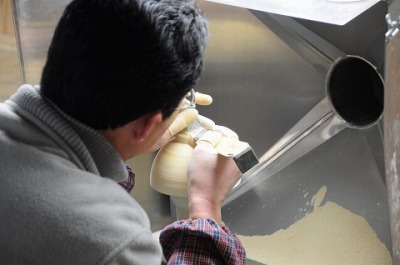Japanese Potteries(Explanations to the technical terms of ceramics No.3)
There are various technical words on potteries.
Here are some of those, for which I'd like to give you some remarks.
KOTE (Trowel)
Kote is a guide to be used when using a potter's wheel. There are various sizes and shapes of potteries and, for making hundreds or thousands of potteries in the same size and shape, some suitable tools are essential as well as skillful technique. I've mentioned last time that diameters and depths are measured with Tombo, while Kote is another tool that determines curves of potteries.
A pottery that was roughly made only with the sense of fingertip are then guided with the Kote from the bottom to side inside, so that it is always shaped with a certain designed curve.
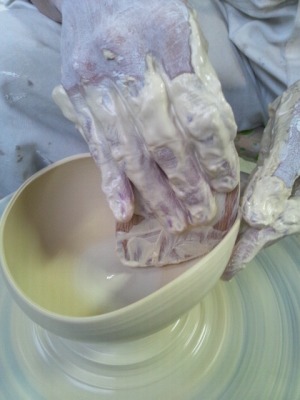
Each individual Kote as much as the number of shapes of pots or plates will be necessary. Pottery artists make such Kote by themselves that has an ideal curve, always looking for appropriate wooden blocks around and shaving them. Free and natural curves produced with a wheel would be good, while well-organized and tensed shapes made with Kote would be also attractive.
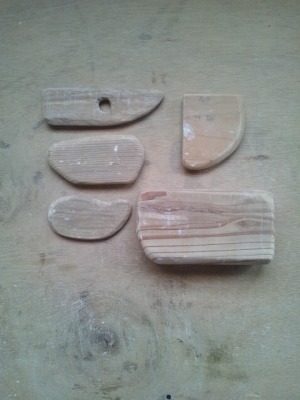
EGOTE (Trowel with a long grip)
Egote is a kind of Kote that has a long grip. How do you think it's used?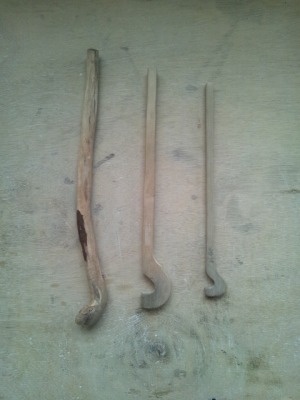
Having a look at its shape, you can't figure out how to use, right? This tool is used when making a product which mouth is narrow. Let's see how to use.
When making a narrow-mouth pottery, your hand can't go inside after the part of mouth is shaped. Then, if you want to puff up the middle part, you insert an Egote inside. You will puff it up slowly from the lower side to upper touching it with the swollen edge of the Egote. By doing so, you can successfully make that swollen shape with leaving the narrow mouth as it is.
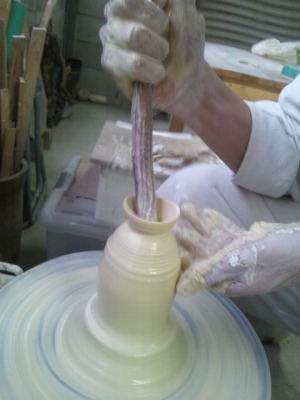
Nowadays you can buy tools easily at specialty shops but some sticklers still go into a mountain, pick up good-shaped branches, shave them and produce their own favorite Egote(s). Tools are like the hands or fingertips of artists. They repeat fine adjustments again and again until the own unique tool becomes to be just nice for using. Such attitude of artists who live in nature get to give feelings of vitality to potteries.
GYUBERA (Pallet)
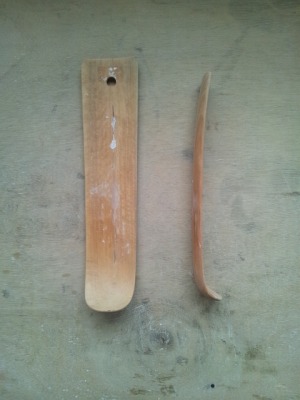
It is a bent board which is also to be used when making products with a potter's wheel. In Arita, when grinding ceramic clay, it is designed to remove marks on a pottery left after grinded with a wheel.
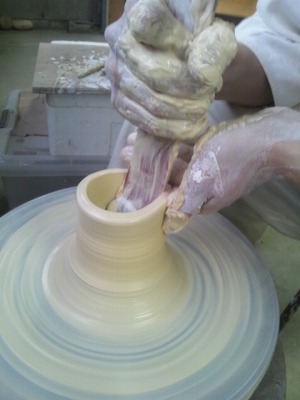
Giving a jerk with a Gyubera at the center of still thick clay, with laying a hand at the other side, you pull up the hand at a stretch so that it can be nicely shaped without having marks inside. As clay is easily affected by moisture, clay may not get lengthen successfully if too much water is used when grinding. By using a Gyubera, clay can get extended easily without adding water. If you lean the Gyubera a little bit, you can make something like a cup which mouth is widely open just as using it like a Kote (trowel). By the way the marks left outside the product can be completely disappeared by polishing the surface after it dries up.
Using Gyubera efficiently would be difficult unless you're well-skilled, but it's actually a very handy tool if you get used to.
The tool came to be named as Gyubera from its shape looking like ox tongue.
KEZURI (to chip or a tool for chipping)
Kezuri means finishing a work by chipping the clay surface around the bottom. I would mention about tools for that.

(From the left, beveled bamboo pallet, bamboo pallet, hoop iron plane, and hard metal plane)
When making pottery, you chip it in the still soft condition of the clay half-dried in which the mouth of it has come not to be moved. If you use the beveled bamboo pallet, you dip up the clay with it like ice cream. Putting the pottery on a hand wheel, you dip twice making 2 half turns to shape the inside of foot.
For shaping the outside of foot, you use a sharpened bamboo pallet and again dip it making half turns. This way is possible only when the clay is still soft, and is good for chipping quickly and making an atmosphere of clay's throb and tenderness.
The hoop iron plane will be used for chipping when the clay has got to be a bit harder than the situation you use the beveled bamboo pallet, in the condition like pushing the surface with your nail doesn't make the part around dent but the mark of nail is remained. You can chip it more easily as the clay is moderately dried and hard to be bent. The atmosphere of foot becomes more like sharp.
The hard metal plane is a tool made of material called super hard tungaloy and mainly used to chip porcelain wares. Porcelain clay is usually chipped 2 times when half-dried and fully dried, but chipping fully dried porcelain with hoop iron plane is a hard work because you have to edge the blade very often. That's why you'd better use a hard metal plane because it's so hard and you can keep chipping with it much easier only by one-time edging of the blade. As chipping fine-grained porcelain clay with very hard plane, the atmosphere of foot will be rational and sharper.
